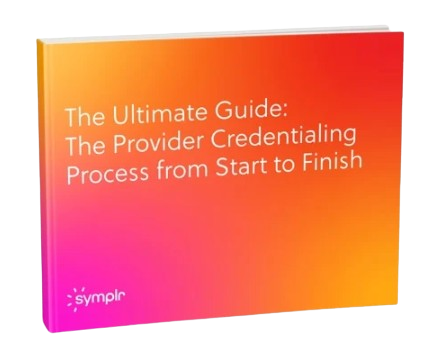Provider Data Management
The Ultimate Guide: The Provider Credentialing Process from Start to Finish

A clearly defined provider credentialing workflow helps to ensure patient safety by validating that only competent providers are administering patient care. In addition to mitigating risk, an effective provider credentialing process also benefits your revenue cycle by allowing your organization to bill for services provided quickly.
Provider credentialing is a multi-step process hospitals and healthcare organizations use to gather and verify practitioners’ qualifications to practice medicine. It’s performed on practitioners who are employed by the organization and those who are affiliated—for example, a physician practicing in the community who applies to be a part of the hospital’s organized medical staff. It is not typically conducted in doctors’ private practices.
What is the provider credentialing process for?
Credentialing is the starting point for hospitals to provide safe, quality healthcare to patients. However, done well, it also protects the hospital and all of its healthcare providers and staff. Credentialing is essential because it entails making sure that an applicant is who they say they are. It’s conducted before:
- A practitioner is allowed to provide care and/or services to patients in the hospital
- A practitioner is enrolled into participating insurance networks and considered "participating” in a commercial or government health plan
Credentialing’s role in the provider lifecycle
This provider credentialing process flow chart depicts where credentialing lies within the larger lifecycle of a provider in a hospital or healthcare organization.
Once a provider who newly presents to an organization is credentialed, onboarded, and practicing within the hospital or system, they undergo a modified credentialing process approximately every two years thereafter.
A hospital’s chosen, non governmental accreditation body (e.g., The Joint Commission, DNV-GL, NCQA) and/or state and governmental regulatory bodies (i.e., Centers for Medicare & Medicaid Services) dictate the guidelines for credentialing. These bodies also set guidelines for which practitioner types in addition to physicians must be credentialed. For example, physician assistants, certified registered nurse assistants, clinical psychologists, and other advanced practice professionals undergo credentialing and then the privileging process. An organization’s own bylaws and policies and procedures round out their own protocols for complying with accreditors and regulators, as well as meeting internal quality and safety goals and measures.
Credentialing workflow structure and tools
Because the credentialing process for healthcare providers is a time-consuming, administrative process that requires coordination of many data points and documents, many organizations either create their own internal Credentialing Verification Organization (CVO) or outsource to a qualified CVO. It’s best practice to ensure that the CVO is certified by the National Committee for Quality Assurance or Utilization Review Accreditation Commission. If not handled by a CVO, credentialing is the responsibility of the Medical Staff Services Department of the hospital—the office tasked with supporting the organized medical staff—or is the responsibility of credentialing staff within the Quality Department of a hospital. Provider enrollment professionals work within the CVO, hospital Medical Staff Services, or Enrollment Department at health plans to conduct credentialing for the purpose of enrolling providers into one or many health plans.
It’s nearly impossible to manage the multi-step process of credentialing for hundreds or thousands of practitioners without automation, so provider data management software is employed. A robust provider management system is capable of making data gathering, secure access, reporting, and ongoing compliance less burdensome for providers, credentialing staff, and the administrators and bodies that conduct final approvals, such as the Credentialing Committee and the Medical Executive Committee.
Credentialing technology solutions offer safeguards and efficiencies that include:
- Knowledge transfer and elimination or reduction of repetitive tasks, manual processes, and human errors that cause delays and increase costs.
- Ability for an increasing number of authorized departments and individuals hospital wide to access the provider data that medical credentialing professionals handle.
- Assurance that the hospital adheres to accreditation and compliance standards
Credentialing process steps
If the applicant—physician, PA, CRNA, or advanced practice professional—will eventually seek clinical privileges in the hospital/healthcare system and his/her services will be billed for, they will undergo credentialing. Note that credentialing’s initial steps—application and primary source verification—are very similar whether they are conducted in unison or separately to:
- Credential to eventually grant clinical privileges (as credentialing professionals in hospitals do).
- Credential to enroll a provider into payers so the hospital can receive reimbursement for services (as enrollment professionals in hospitals, CVOs, or insurers/health plans do).
The key differences when primary source verification is conducted separately for these two goals is that more data may be collected for the credentialing-to-privilege process.

